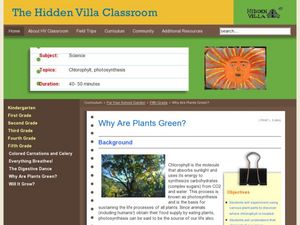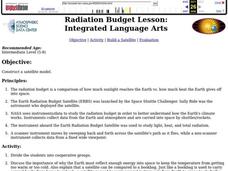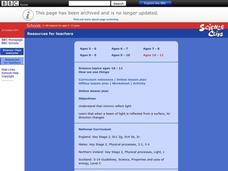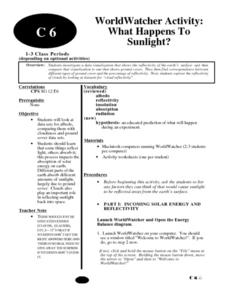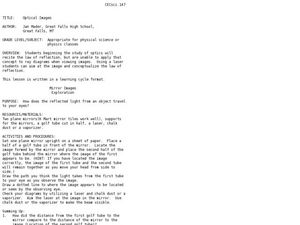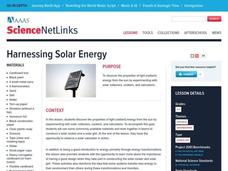Curated OER
Astronomy
A broad sampling of material related to stars is covered here. You will want to review each question to see if it corresponds to your curriculum. The formatting is inconsistent, but easily corrected if you use the information to create...
Curated OER
Why Are Plants Green?
Pupils smash plant parts and wait for visibility of chlorophyl to show why plants turn green. In this green plants lesson plan, students use acetone and filter paper for this experiment.
Curated OER
What Should I Know About Photosynthesis
This four-page handout would work great as a reading guide or note-taking resource for teens learning about ATP, photosynthesis, the key scientists in the realm of photosynthesis, and more. It is designed to accompany a certain textbook,...
Curated OER
Cooler In The Shadows
Students investigate the concepts of shadows and how they are projected with objects different positions in relation to the sun. They conduct an experiment by observing objects in different positions. Then students record the observations.
Curated OER
The Abiotic Limits to Purple Loosestrife Growth
Young scholars investigate the effects of soil temperature, water availability, photo period and other variables of the growth of purple loosestrife. They observe the growing conditions of plants and alter them by adding water, isolating...
Curated OER
Solar Cell Simulation
Students study photovoltaic technology. In this photovoltaic technology lesson, students simulate a photovoltaic system. Students discuss how to simulate a cloudy day.
Curated OER
How Do Bats Navigate At Night?
Through an experiment, learners explore how bats use echolocation. First, they discuss how sound travels through air waves. Then, they talk about the ways bats navigate in the dark. As an extension, they can write about what they have...
Curated OER
Radiation Budget
Students examine the radiation budget and the launching of the Budget Satellite. They role-play as designers of the satellite and construct one with a power source, instruments, and sensors. they explain how their satellite functions...
Curated OER
Investigation 3 - What is Moonlight?
Third graders observe a demonstration explaining that the moon reflects sunlight in ordr to shine.
Curated OER
Enlightening Explorations, Part III
Sixth graders continue their examination of light. In groups, they make rainbows and examine the spectrum of visible light. They travel between various stations recording their observations about the behaviors of light. To end the...
Curated OER
Enlightening Explorations, Part II
Sixth graders review their results from the previous experiments. After viewing a kaleidoscope, they make their own pattern on paper and describe the role of light. To end the lesson, they examine light being relfected and refracted and...
Curated OER
Exploring With Photograms
Students observe the interaction between energy absorbed, reflected or transmitted through an object in a photochemical process with a classroom demonstration.
Curated OER
How We See Things
Students explain that mirrors reflect light. They examine how when a beam of light is reflected from a surface, its direction changes.
Curated OER
Bouncing Sunlight
Third graders use flashlights and balls to demonstrate how the light bounces off of the sun and reflects onto the moon. They record their observations in a journal.
Curated OER
WorldWatcher Activity: What Happens to Sunlight?
Learners examine a set of data to try to determine the amount of cloud cover. In groups, they make a list of items that reflect light in the atmosphere and how different amounts of it can change the temperature. Using WorldWatcher,...
Curated OER
Optical Images
Ninth graders study optics and the law of reflection. In this optical images lesson students use a laser and conceptualize the law of reflection.
Curated OER
Canned Heat
Young scholars demonstrate that light and dark colored objects absorb the sun's radiation at different rates. They experiment with the temperature change of water in two locations and discuss the results.
Curated OER
Radiation from Space
In this radiation worksheet, students review the different types of radiation waves that come from space and the different telescopes used to detect this radiation. This worksheet has 17 true or false questions.
Curated OER
Jell-O Optics
Learners observe an activity with Jell-O to learn about optics. In this investigative lesson students fill out a handout on the activity that helps them to investigate the index of refraction and the speed of light.
Curated OER
A Brand New Day
Learners locate Maine on a classroom map and discuss if Maine is where the nation's first light is found, where would the nation's last light be seen. They explore the idea of the sun rising in the east and setting in the west.
Curated OER
Harnessing Solar Energy
Learners identify the properties of light from the sun. In groups, they participate in experiments with solar collectors, cookers and calculators to determine which one harnesses the most energy. They record their observations and...
Curated OER
Solar Energy: Become a Sun Chef!
Students design and construct a solar cooker. They use the Internet to research solar collectors and the process of changing light energy into heat energy.
Curated OER
Modeling Day and Night
Students complete a science experiment to study the role of night and day on sleep patterns. In this sleep patterns lesson, students brainstorm about night and day and the causes for the rotations on Earth. Students work in groups to...
Curated OER
The Fog Won't Cloud Your Artist's Eye
Students examine art that shows some type of weather event. After watching two filmstrips on weather, they create a fog picture of themselves and read about lighting and thunder. They paint pictures in the style of five artists they have...

